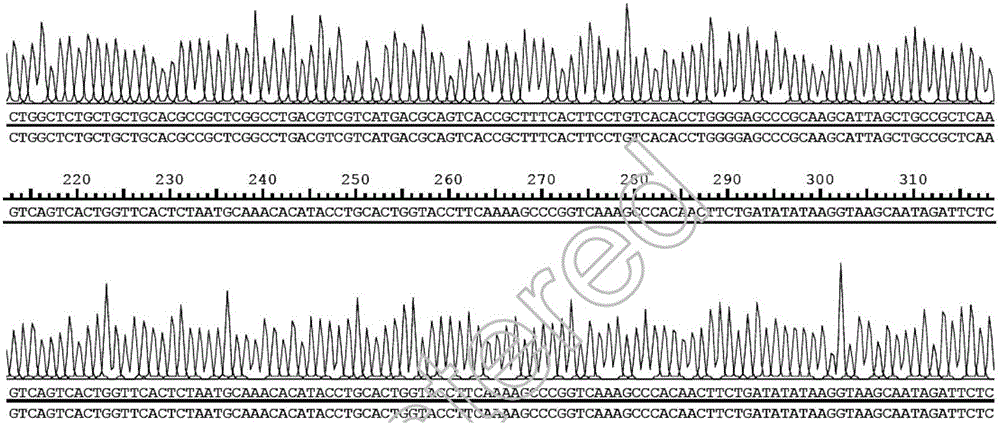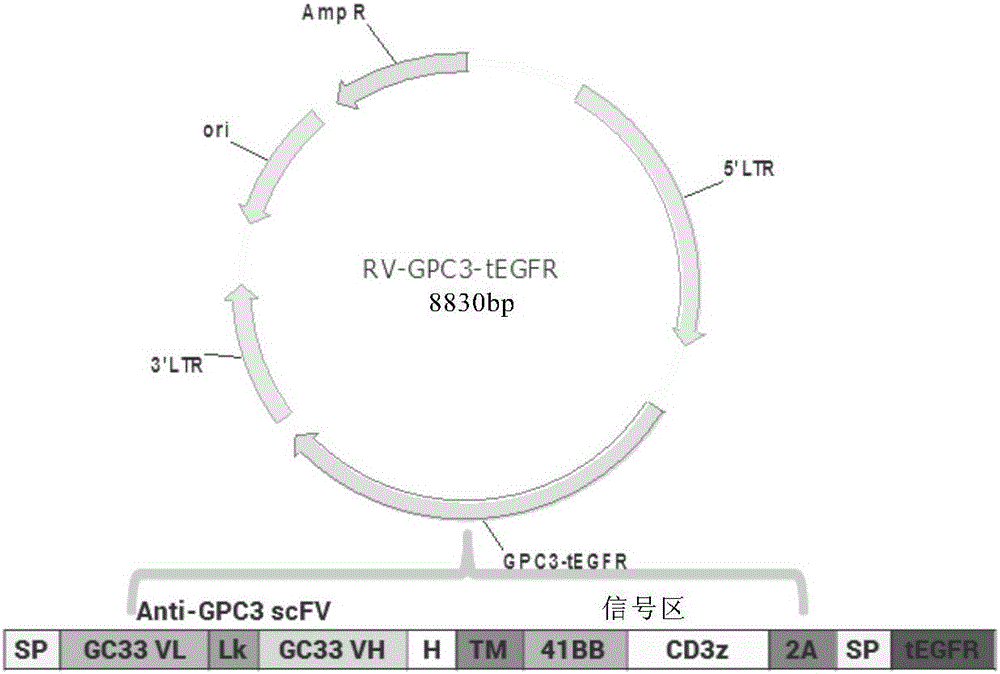Chimeric antigen receptor of targeted GPC3 (Glypican 3) and application thereof
An antigen, single-chain antibody technology, applied in applications, hybrid peptides, anti-tumor drugs, etc., can solve problems such as not having a good effect
- Summary
- Abstract
- Description
- Claims
- Application Information
AI Technical Summary
Problems solved by technology
Method used
Image
Examples
Embodiment 1
[0122] Example 1: Determination of mGPC3scFv-CD8α-41BB-CD3ζ gene sequence
[0123] The gene sequence information of human CD8α hinge region, human CD8α transmembrane region, human 41BB intracellular region and human CD3ζ intracellular region was searched from the NCBI website database. The anti-GPC3 single chain antibody clone number is GC33. These sequences are available on the website Codon optimization is performed on http: / / sg.idtdna.com / site to ensure that it is more suitable for human cell expression without changing the encoded amino acid sequence.
[0124] Using overlapping PCR, the above sequences were sequentially connected according to anti-GPC3 scFv, human CD8α hinge region gene, human CD8α transmembrane region gene, human 41BB intracellular region gene, and human CD3ζ intracellular region gene sequence, and different restriction enzymes were introduced at the junction of each sequence site, forming the complete mGPC3-CAR gene sequence information, and obtaining th...
Embodiment 2
[0131] Example 2: Determination of mGPC3CAR-tEGFR gene sequence
[0132] The human EGFR extracellular region gene sequence information was searched from the NCBI website database, and the sequence was codon-optimized on the website http: / / sg.idtdna.com / site to ensure that it is more suitable for human cells without changing the encoded amino acid sequence Express.
[0133] Using overlapping PCR, the above sequences were sequentially connected according to the GPC3CAR, GMCSFR leader sequence, and tEGFR in Example 1, and different restriction sites were introduced at the junctions of each sequence to form complete mGPC3CAR-tEGFR gene sequence information, and the CAR molecule was obtained. As shown in SEQ ID NO:1, the encoded amino acid sequence is shown in SEQ ID NO:2.
[0134] The nucleotide sequence of the CAR molecule was double-digested with NotI (NEB) and EcoRI (NEB), connected and inserted into the NotI-EcoRI site of retrovirus MSCV (Addgene) by T4 ligase (NEB), and tran...
Embodiment 3
[0140] Example 3: Retroviral Packaging
[0141] 1. Day 1: 293T cells should be less than 20 passages, not overgrown. Plate at 0.6*10^6 cells / ml, add 10ml of DMEM medium to a 10cm dish, mix the cells well, and culture overnight at 37 degrees.
[0142] 2. Day 2: 293T cell confluency reaches about 90% for transfection (usually about 14-18h after plating); prepare plasmid complexes, the amount of various plasmids is 12.5ug of the MSCV backbone vector of Example 1 or 2, Gag-pol10ug, VSVg 6.25ug, CaCl 2 250ul,H 2 O 1ml, the total volume is 1.25ml; add HBS equal to the volume of the plasmid complex in another tube, and vortex for 20 seconds while adding the plasmid complex. Gently add the mixture to the 293T dish along the side, incubate at 37°C for 4 hours, remove the medium, wash with PBS, and add pre-warmed fresh medium again.
[0143] 3. Day 4: 48 hours after transfection, collect the supernatant and filter it with a 0.45um filter, store in -80°C, and continue to add preheat...
PUM
 Login to View More
Login to View More Abstract
Description
Claims
Application Information
 Login to View More
Login to View More - R&D
- Intellectual Property
- Life Sciences
- Materials
- Tech Scout
- Unparalleled Data Quality
- Higher Quality Content
- 60% Fewer Hallucinations
Browse by: Latest US Patents, China's latest patents, Technical Efficacy Thesaurus, Application Domain, Technology Topic, Popular Technical Reports.
© 2025 PatSnap. All rights reserved.Legal|Privacy policy|Modern Slavery Act Transparency Statement|Sitemap|About US| Contact US: help@patsnap.com



